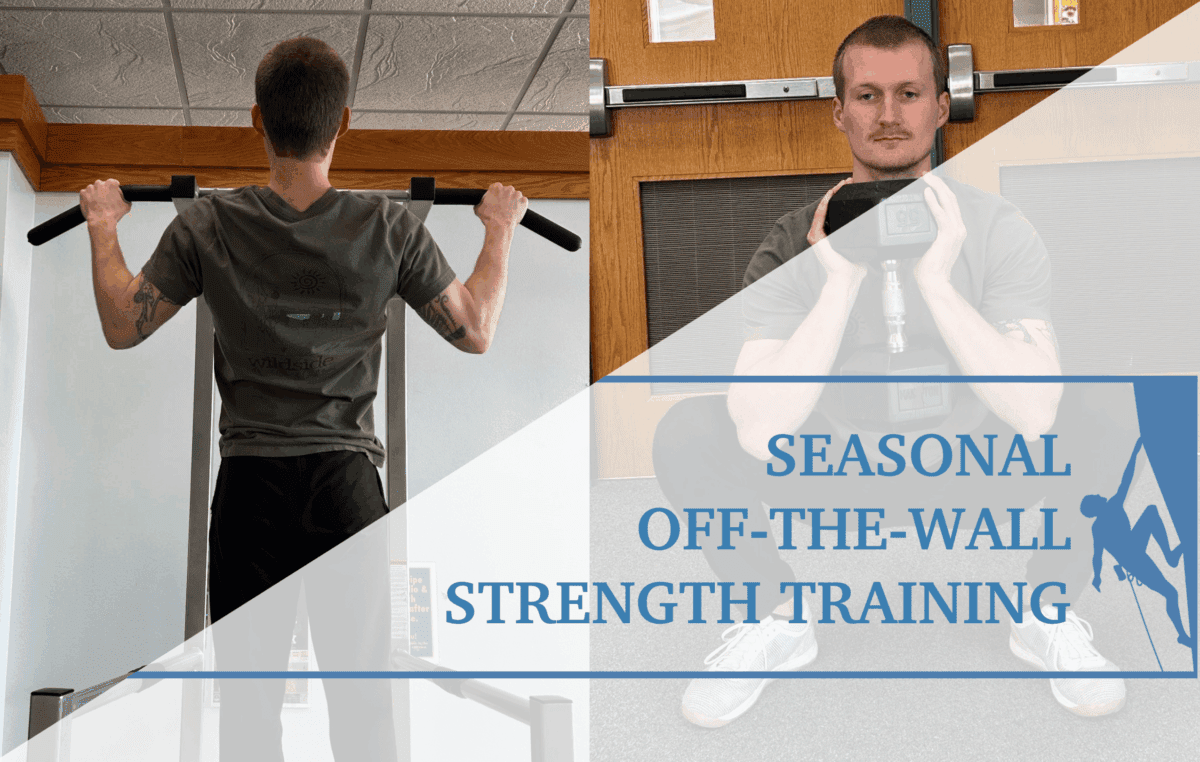Preventing Work Related Injuries Among Route Setters
Rock climbing as a sport and a lifestyle has been around for centuries. However, climbing began its transition to the industry it is today just as recently as 1987 with the opening of the first indoor climbing gym. Since then, the total number of climbing gyms worldwide has risen to 2,167 according to indoorclimbing.com. The growth of the industry over the past 30 years has created a number of professions centered around indoor rock climbing. Route setters make up one of these professions and are a fundamental component of the indoor rock climbing industry.
Route setters are the people who create and place routes on the walls of a climbing gym using manufactured holds. Basically, they make the fun! These individuals fall into the category of industrial athletes because their job requires creativity, a fundamental knowledge of climbing movements, lots of heavy lifting and hauling, the use of power tools, and a LOT of climbing. Just like in other industries, quality assurance is vital before putting a product out to the public. However, QA for route setters requires hours of forerunning, which involves climbing routes repetitively to assess quality and difficulty before customers are able to climb them.
How the Demands the of Job Present as Issues/Injuries:
Climbing, like any sport, lends itself to certain injuries, most of which occur secondary to overuse and muscular imbalances that develop due to the specific demands of the sport. Common injuries often involve the neck, shoulders, elbows, and hands. It is likely that route setters experience these same injuries at a higher rate due to the added demands of their job, in addition to climbing outside of work which may exaggerate common muscular imbalances.
As the industry continues to grow, so do the demands of the job. Route setters are often part- or full-time employees at climbing gyms expected to work multiple days in a row throughout the week. Charlotte, NC area route setters report an average 3.8 consecutive days route setting per week with an average of 9-hour days. The amount of work can sometimes increase when preparing for competitions or gym events. Included in their total work volume, route setters reported an average of around 11.5 hours suspended in their harness per week. In addition to their weekly work schedule, most route setters also reported attempts to climb outside of work on a weekly basis which varied greatly between individuals with some reporting an inability to climb outside of work due to work related injuries or fatigue. Total volume of work hours in addition to total time spent in their harness and time spent climbing outside of work should all be considered when determining risk for injury.
Local Route Setter Screening:
The information listed in this article was collected from a screening of local Charlotte, NC area route setters. This screening involved a questionnaire inquiring about weekly setting schedule, time spent climbing outside of work, and history of injuries, as well as a range of motion and strength assessment. This information was collected in attempts to better understand the demands of the job, common injuries among route setters, and if there are correlations between common deficits in strength and mobility with injury.
Common Injuries Among Route Setters:
100% of local route setters report:
- Low back pain
- Finger/hand pain (with or without associated pulley injury)
Over 80% report:
- Knee pain
- Wrist pain
Over 50% report:
- Shoulder pain
- Elbow pain
It is important to note that 100% of local route setters reported their injuries as chronic and strongly associated each injury with the demands of their job. In addition, most setters reported stiff and tight muscles with associated trigger points.
Common patterns of strength and mobility deficits:
100% of local route setters displayed:
- Decreased lumbar range of motion in 1 or more planes
- Decreased shoulder ROM in 1 or more planes
- Decreased strength of parascapular muscles (middle trapezius, lower trapezius, rhomboids, serratus anterior)
Over 50% displayed:
- Decreased shoulder strength in overhead positions
It is important to note that strengths and weaknesses are relative to the individual. As industrial athletes, route setters are generally strong and fit individuals but due to the demands of their job certain muscular imbalances or mobility deficits can become exaggerated secondary to repetitive overuse and fatigue. This is why it is important to understand these common deficit patterns. It provides areas to target with either strength or mobility exercises which can promote longevity in their careers as route setters and climbers.
Injury Prevention for Route Setters:
As mentioned previously, injury prevention for route setters should take a multifactorial approach that is individualized to a setter’s unique imbalances and deficits. This should include education on adequate warmups, rest and nutrition, exercise to address strength and mobility deficits, as well as mental breaks to prevent burn out and keep their stoke high with regards to work and climbing for leisure. Based on the common patterns found among local route setters, here is a list of strength and flexibility exercises to include in any route setters training toolbox:
Spinal Stretches:
This video displays a spinal mobility routine to help route setters with stiff backs get through those long hard days suspended in a harness, drilling holds, and forerunning routes. This routine addresses all segments of the spine with a focus on lumbar and thoracic mobility. It includes lower trunk rotations, cat-cow spinal flexion and extension, as well as half kneeling thoracic rotation.
This routine can be performed dynamically, as in the videos, as part of a dynamic warm up before starting a day of setting but can also be performed statically as a cool down following the day. As a warmup, shoot for continuous movement with brief pauses at end range for about 2 minutes each exercise. As a cool down, pause at end range for 30-60 seconds, 3 times each direction.
Upper Body Stretches:
This video contains upper body stretches and soft tissue mobilization exercises addressing common mobility restrictions found in a local group of route setters. It includes a Latissimus Dorsi stretch and soft tissue mobilization technique, as well as a sleeper stretch. The Lat stretch and foam rolling target common deficits in overhead flexion which is essential for route setters. This stretch can be performed at a squat rack or in a doorway. It should be held for 30 seconds to a minute each side. The foam rolling technique should be performed for 2-3 minutes, finding tender spots and pausing over these areas for 3-5 breathes. The sleeper stretch addresses restrictions in the posterior rotator cuff and posterior glenohumeral capsule. This exercise should be held for 30 seconds to a minute as well, making sure to only apply a gentle stretch at end range.
Parascapular and Shoulder Girdle Strengthening:
This video contains exercises addressing common weaknesses of the shoulder girdle noted in a local group of route setters, including wall angels and serratus anterior wall slides. These exercises are simple but challenging, requiring minimal equipment. These exercises target weakness in functional positions for route setters, especially overhead reaching. Perform these exercises after completing the mobility routines listed above or on their own. 3 to 5 sets of each should be completed with a target repetition range of 15-20 for muscle endurance.
Resources for Head Setters:
Here is a list of websites and resources head setters can utilize to prevent burnout and reduce their setting teams’ risk for injury
See a Physical Therapist:
The impairments and exercises listed in this article are specific to a group of local route setters. They can be generalized to an extent for those dealing with similar deficits. However, individuals suffering from long standing issues related to rock climbing or route setting should seek out the help of a physical therapist for a specific diagnosis and treatment plan tailored to their unique needs.
About the Author:

Tyler Steele, PT, DPT is a physical therapist in the Charlotte, NC area. He has been rock climbing for 8 years and recently completed mentorship in the Climbing Doctors Special Interest Group designed to educate DPT students on movement analysis, diagnosis, and treatment of climbing related injuries. He has a passion for combining his climbing background with his knowledge of physical therapy to help other climbers maintain their health and promote longevity in the sport.
If you have any questions regarding this article or related to physical therapy for climbers or route setters, you can connect with Tyler via the following platforms:
Email: tylersteele280@gmail.com
Instagram: @tb_steele
References:
- Marshall, R. (2016, February 29). Setters’ health. Climbing Business Journal. Retrieved March 15, 2022, from https://www.climbingbusinessjournal.com/setters-health/
- Michael Callihan, Megan Leonard. Training the Industrial Athlete: Targeted Exercises to Reduce Occupational Injury Risks. Journal of Orthopaedics and Sports Medicine 3 (2021): 152-161.
- Moran, H. (n.d.). (route)setting good standards: Prevent burnout, support your team. (Route)Setting Good Standards: Prevent Burnout, Support Your Team – Climbing Wall Association. Retrieved March 15, 2022, from https://www.cwapro.org/blog/routesetting-good-standards-prevent-burnout-support-your-team
- Russell, S. (2021, January 26). Common route setting injuries and how to prevent them. Union Physical Therapy. Retrieved March 15, 2022, from https://www.unionpt.com/route-setting-injuries/
- Disclaimer – The content here is designed for information & education purposes only and the content is not intended for medical advice.




